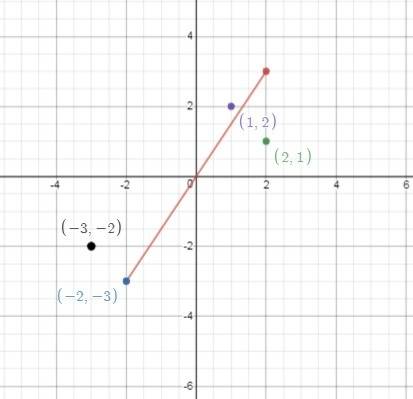
Mathematics, 14.07.2019 15:00 avalonr2003
The graph of an equation is shown below: line joining ordered pairs negative 2, negative 3 and 2,3 based on the graph, which of the following represents a solution to the equation? a (−2,−3) b (2, 1) c (1, 2) d (−3, −2)

Answers: 1


Another question on Mathematics

Mathematics, 21.06.2019 17:50
Eric has challenged himself to walk 24,000 steps in 4 days. if eric walks the same number of steps each day, which function represents the number of steps eric still needs to walk to reach his goal with respect to the number of days since he started his challenge? a. y = 8,000x − 24,000 b. y = -8,000x + 24,000 c. y = 6,000x − 24,000 d. y = -6,000x + 24,000
Answers: 1

Mathematics, 21.06.2019 19:30
Asquare picture with sides of 32 inches is to be mounted on a square mat with sides of 52 inches. find the area of the mat that will remain uncovered by the picture.
Answers: 1

Mathematics, 21.06.2019 21:40
The sides of a parallelogram are 24cm and 16cm. the distance between the 24cm sides is 8 cm. find the distance between the 16cm sides
Answers: 3

Mathematics, 21.06.2019 22:10
If p(a) = 0.70 and p(b) = 0.20, then a and b are independent events if
Answers: 3
You know the right answer?
The graph of an equation is shown below: line joining ordered pairs negative 2, negative 3 and 2,3...
Questions




Mathematics, 04.07.2020 19:01









Biology, 04.07.2020 19:01

Mathematics, 04.07.2020 19:01

History, 04.07.2020 19:01















 ------> the ordered pair is a solution of the linear equation
------> the ordered pair is a solution of the linear equation

 ------> the ordered pair is not a solution of the linear equation
------> the ordered pair is not a solution of the linear equation

 ------> the ordered pair is not a solution of the linear equation
------> the ordered pair is not a solution of the linear equation

 ------> the ordered pair is not a solution of the linear equation
------> the ordered pair is not a solution of the linear equation


 ,
,

 .
.


